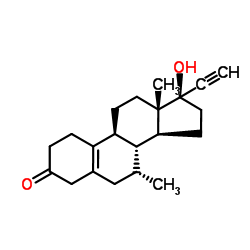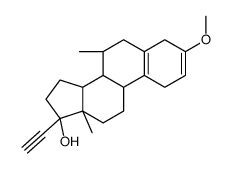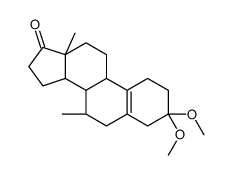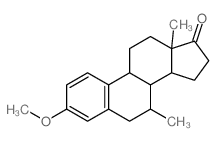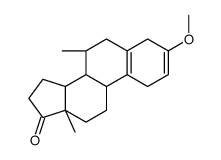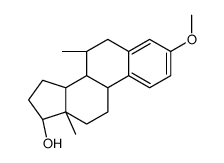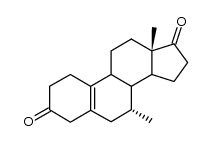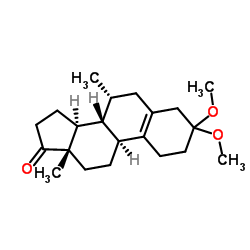5630-53-5
| 中文名 | 替勃龙 |
|---|---|
| 英文名 | tibolone |
| 中文别名 | 17-羟基-7alpha-甲基-19-去甲孕甾-5(10)-烯-20-炔-3-酮 |
| 英文别名 |
EINECS 227-069-1
17-Hydroxy-7α-methyl-19-nor-17α-pregn-5(10)-en-20-yn-3-one Tibolone 7a-Methyl-5,10-norethindrone 7a-Methyl-17a-ethynyl-17b-hydroxy-19-norandrost-5(10)-en-3-one LIVIELLA Org OD 14 (7α,17α)-17-Hydroxy-7-methyl-19-norpregn-5(10)-en-20-yn-3-one 7a-Methyl-D5,10-norethindrone (7R,8R,9S,13S,14S,17R)-17-Ethynyl-17-hydroxy-7,13-dimethyl-1,2,4,6,7,8,9,11,12,13,14,15,16,17-tetradecahydro-3H-cyclopenta[a]phenanthren-3-one Livial 7a-Methyl-17a-ethynyl-17b-hydroxyestr-5(10)-en-3-one MFCD00864178 (7a,17a)-17-Hydroxy-7-methyl-19-norpregn-5(10)-en-20-yn-3-one |
| 描述 | 替勃龙是一种广谱性腺类固醇激动剂,具有孕激素、雄激素和雌激素活性。替勃龙可用于绝经后骨质疏松症研究[1][2]。 |
|---|---|
| 相关类别 | |
| 体内研究 | 替勃龙(1毫克/天;口服给药;治疗12周)可增强去卵巢大鼠髓内钛植入物的骨整合过程[1]。动物模型:切除卵巢的雌性白化Wistar大鼠[1]剂量:1mg/天给药:口服;每日的12周后的结果:显示整体骨组织显著增加,体重密度显著增加。 |
| 参考文献 |
| 密度 | 1.1±0.1 g/cm3 |
|---|---|
| 沸点 | 447.4±45.0 °C at 760 mmHg |
| 熔点 | 169 °C |
| 分子式 | C21H28O2 |
| 分子量 | 312.446 |
| 闪点 | 190.6±21.3 °C |
| 精确质量 | 312.208923 |
| PSA | 37.30000 |
| LogP | 4.03 |
| 外观性状 | 白色至灰白色结晶粉末 |
| 蒸汽压 | 0.0±2.5 mmHg at 25°C |
| 折射率 | 1.570 |
| 储存条件 | 避光,阴凉干燥处,密封保存 |
| 稳定性 | 常温常压下稳定 |
| 分子结构 | 1、 摩尔折射率:89.95 2、 摩尔体积(m3/mol):274.1 3、 等张比容(90.2K):719.4 4、 表面张力(dyne/cm):47.4 5、 极化率(10 -24cm 3):35.65 |
| 计算化学 | 1、 疏水参数计算参考值(XlogP):2.4 2、 氢键供体数量:1 3、 氢键受体数量:2 4、 可旋转化学键数量:1 5、 互变异构体数量:8 6、 拓扑分子极性表面积(TPSA):37.3 7、 重原子数量:23 8、 表面电荷:0 9、 复杂度:636 10、 同位素原子数量:0 11、 确定原子立构中心数量:6 12、 不确定原子立构中心数量:0 13、 确定化学键立构中心数量:0 14、 不确定化学键立构中心数量:0 15、 共价键单元数量:1 |
| 更多 | 1. 性状:未确定 2. 密度(g/mL,25/4℃):未确定 3. 相对蒸汽密度(g/mL,空气=1):未确定 4. 熔点(ºC):165-169 5. 沸点(ºC,常压):未确定 6. 沸点(ºC,5.2kPa):未确定 7. 折射率:105 8. 闪点(ºC):未确定 9. 比旋光度(º):未确定 10. 自燃点或引燃温度(ºC):未确定 11. 蒸气压(kPa,25ºC):未确定 12. 饱和蒸气压(kPa,60ºC):未确定 13. 燃烧热(KJ/mol):未确定 14. 临界温度(ºC):未确定 15. 临界压力(KPa):未确定 16. 油水(辛醇/水)分配系数的对数值:未确定 17. 爆炸上限(%,V/V):未确定 18. 爆炸下限(%,V/V):未确定 19. 溶解性:未确定 |
|
Section I.Chemical Product and Company Identification Chemical Name Tibolone Portland OR Synonym17α-Hydroxy-7α-methyl-19-norpregn-5(10)-en-20-yn- 3-one Chemical FormulaC21H28O2 CAS Number5630-53-5
Section II.Composition and Information on Ingredients Toxicology Data Chemical NameCAS Number Percent (%)TLV/PEL Tibolone5630-53-5 Min. 98.0 (GC) Not available.Not available. Section III. Hazards Identification Acute Health EffectsNo specific information is available in our data base regarding the toxic effects of this material for humans. However, exposure to any chemical should be kept to a minimum. Skin and eye contact may result in irritation. May be harmful if inhaled or ingested. Always follow safe industrial hygiene practices and wear proper protective equipment when handling this compound. Chronic Health EffectsCARCINOGENIC EFFECTS : Not available. MUTAGENIC EFFECTS : Not available. TERATOGENIC EFFECTS : Not available. DEVELOPMENTAL TOXICITY: Not available. Repeated or prolonged exposure to this compound is not known to aggravate existing medical conditions. Section IV.First Aid Measures Eye ContactCheck for and remove any contact lenses. In case of contact, immediately flush eyes with plenty of water for at least 15 minutes. Get medical attention. Skin ContactIn case of contact, immediately flush skin with plenty of water. Remove contaminated clothing and shoes. Wash clothing before reuse. Thoroughly clean shoes before reuse. Get medical attention. If the victim is not breathing, perform mouth-to-mouth resuscitation. Loosen tight clothing such as a collar, tie, belt or Inhalation waistband. If breathing is difficult, oxygen can be administered. Seek medical attention if respiration problems do not improve. IngestionINDUCE VOMITING by sticking finger in throat. Lower the head so that the vomit will not reenter the mouth and throat. Loosen tight clothing such as a collar, tie, belt or waistband. If the victim is not breathing, perform mouth-to-mouth resuscitation. Examine the lips and mouth to ascertain whether the tissues are damaged, a possible indication that the toxic material was ingested; the absence of such signs, however, is not conclusive. Section V.Fire and Explosion Data Not available. May be combustible at high temperature.Auto-Ignition Flammability Flash PointsFlammable LimitsNot available. Not available. These products are toxic carbon oxides (CO, CO2). Combustion Products Fire Hazards Not available. Risks of explosion of the product in presence of mechanical impact: Not available. Explosion Hazards Risks of explosion of the product in presence of static discharge: Not available. Fire Fighting Media SMALL FIRE: Use DRY chemical powder. LARGE FIRE: Use water spray, fog or foam. DO NOT use water jet. and Instructions Consult with local fire authorities before attempting large scale fire-fighting operations. Continued on Next Page Tibolone Section VI.Accidental Release Measures Spill CleanupUse a shovel to put the material into a convenient waste disposal container. Finish cleaning the spill by rinsing any contaminated surfaces with copious amounts of water. Consult federal, state, and/or local authorities for assistance on Instructions disposal. Section VII. Handling and Storage Handling and StorageKeep away from heat. Mechanical exhaust required. When not in use, tightly seal the container and store in a dry, cool place. Avoid excessive heat and light. Do not breathe dust. Information Always store away from incompatible compounds such as oxidizing agents. Section VIII. Exposure Controls/Personal Protection Use process enclosures, local exhaust ventilation, or other engineering controls to keep airborne levels below recommended Engineering Controls exposure limits. If user operations generate dust, fume or mist, use ventilation to keep exposure to airborne contaminants below the exposure limit. Splash goggles. Lab coat. Dust respirator. Boots. Gloves. Suggested protective clothing might not be sufficient; consult a Personal Protection specialist BEFORE handling this product. Be sure to use a MSHA/NIOSH approved respirator or equivalent. Exposure LimitsNot available. Section IX. Physical and Chemical Properties Solid. (Crystal, powder. White - almostSolubility Physical state @ 20°CNot available. white.) Not available. Specific Gravity Molecular Weight312.45Partition CoefficientNot available. Boiling Point Not available.Vapor PressureNot applicable. Melting Point169°C (336.2°F)Vapor DensityNot available. Refractive IndexNot available.VolatilityNot available. Critical TemperatureNot available.OdorNot available. Not available.Not available. ViscosityTaste Section X.Stability and Reactivity Data This material is stable if stored under proper conditions. (See Section VII for instructions) Stability Conditions of InstabilityAvoid excessive heat and light. Incompatibilities Reactive with oxidizing agents. Section XI. Toxicological Information RTECS NumberRC8964020 Eye Contact. Ingestion. Inhalation. Routes of Exposure Not available. Toxicity Data Chronic Toxic EffectsCARCINOGENIC EFFECTS : Not available. MUTAGENIC EFFECTS : Not available. TERATOGENIC EFFECTS : Not available. DEVELOPMENTAL TOXICITY: Not available. Repeated or prolonged exposure to this compound is not known to aggravate existing medical conditions. No specific information is available in our data base regarding the toxic effects of this material for humans. However, Acute Toxic Effects exposure to any chemical should be kept to a minimum. Skin and eye contact may result in irritation. May be harmful if inhaled or ingested. Always follow safe industrial hygiene practices and wear proper protective equipment when handling this compound. Section XII.Ecological Information EcotoxicityNot available. Environmental FateNot available. Continued on Next Page Tibolone Section XIII. Disposal Considerations Waste DisposalRecycle to process, if possible. Consult your local regional authorities. You may be able to dissolve or mix material with a combustible solvent and burn in a chemical incinerator equipped with an afterburner and scrubber system. Observe all federal, state and local regulations when disposing of the substance. Section XIV. Transport Information DOT ClassificationNot a DOT controlled material (United States). PIN NumberNot applicable. Proper Shipping NameNot applicable. Packing Group (PG)Not applicable. DOT Pictograms Section XV. Other Regulatory Information and Pictograms TSCA Chemical InventoryThis product is NOT on the EPA Toxic Substances Control Act (TSCA) inventory. The following notices are required by 40 CFR 720.36 (C) for those products not on the inventory list: (EPA) (i) These products are supplied solely for use in research and development by or under the supervision of a technically qualified individual as defined in 40 CFR 720.0 et sec. (ii) The health risks of these products have not been fully determined. Any information that is or becomes available will be supplied on an MSDS sheet. WHMIS ClassificationNot controlled under WHMIS (Canada). (Canada) EINECS Number (EEC) 227-069-1 EEC Risk Statements Not available. SECTION 16 - ADDITIONAL INFORMATION N/A |
|
生态学数据: 通常对水是不危害的,若无政府许可,勿将材料排入周围环境.
|
| 符号 |

GHS07 |
|---|---|
| 信号词 | Warning |
| 危害声明 | H319 |
| 警示性声明 | P305 + P351 + P338 |
| 危害码 (欧洲) | N |
| 风险声明 (欧洲) | R51/53 |
| 安全声明 (欧洲) | S22-S24/25-S61 |
| 危险品运输编码 | UN 3077 9/PG 3 |
| RTECS号 | RC8964020 |
| 上游产品 10 | |
|---|---|
| 下游产品 2 | |


